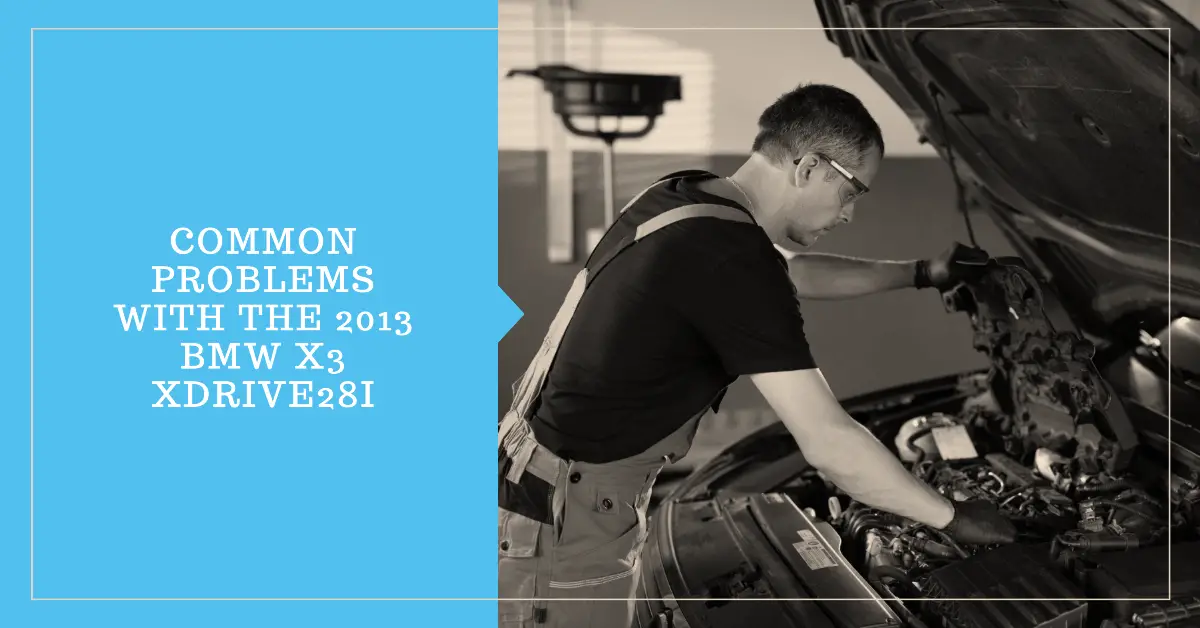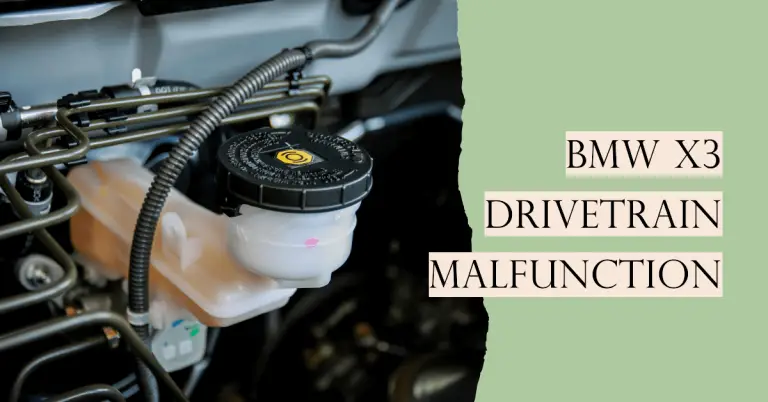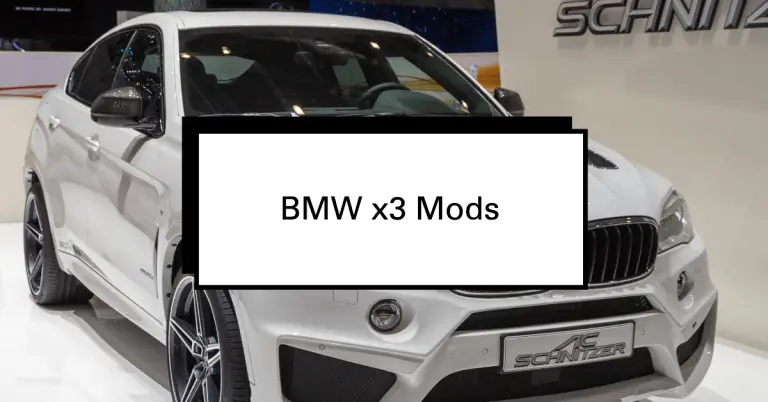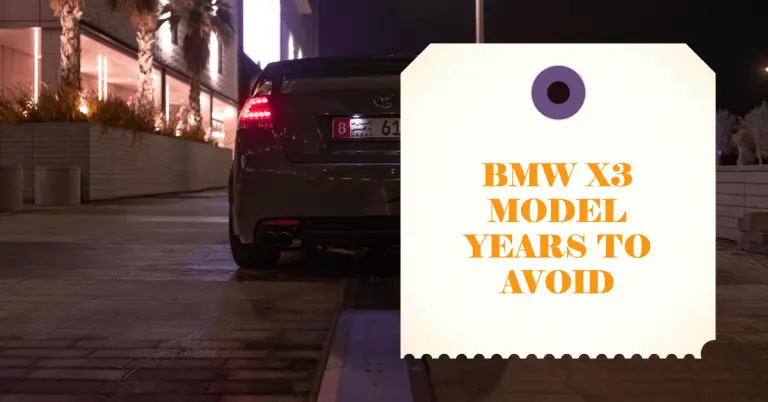Major Issues to Know About the 2013 BMW X3 xDrive28i
When it comes to compact luxury SUVs, the BMW X3 has long been a top choice for driving enthusiasts seeking both on-road agility and off-road capability. Among the more popular models is the 2013 BMW X3 xDrive28i, which comes equipped with a punchy 240-horsepower turbocharged engine, sport-tuned suspension, and BMW’s renowned xDrive all-wheel drive system.
However, even this capable luxury crossover is not without its problems. So what are the most common issues with the 2013 X3 xDrive28i that owners should look out for?
In a nutshell, the major problem areas include the engine, electrical system, suspension, and transmission. By being aware of the specific problems that tend to afflict the 2013 X3, you can help minimize maintenance costs and repairs through proactive maintenance and early issue detection.
In this 2500+ word blog post, we will take an in-depth look at real world problems experienced by 2013 X3 owners, digging into root causes and repair options for issues with:
- The N20 turbocharged engine
- Electrical gremlins ranging from faulty batteries to problematic sunroofs
- Premature suspension wear leading to steering shimmy and noise
- Transmission faults resulting in slipping, jerking, and rough shifting
We’ll also discuss how reliable the 2013 X3 is versus other model years, providing key statistics on repair frequency and maintenance costs. Let’s get started exploring what went wrong under the hood for this usually capable compact luxury SUV.
Turbocharged Engine Problems Plague the 2013 X3 xDrive28i
The 2013 X3 xDrive28i comes equipped with BMW’s N20 2.0L twin-scroll single turbo engine, generating 240 horsepower and 260 lb-ft torque. This motor gives the X3 sprightly acceleration and passing power, hustling from 0 to 60 mph in just 6.2 seconds.
However, even fairly new N20 engines in 2013 models have developed a number of recurring issues that negatively impact power delivery and reliability. Here are the most common engine problems with the 2013 BMW X3 xDrive28i:
Oil Leaks from Valve Cover and Oil Filter Housing Gaskets
On 2013 X3 models with the N20 turbo engine, the valve cover gasket and oil filter housing gasket tend to deteriorate prematurely, allowing oil to slowly seep out. Owners may notice smoke coming from the engine bay, drips of oil on the ground, or low oil level warnings caused by the gradual seepage.
Replacing the valve cover gasket runs around $150-300 at an independent mechanic, while the more labor intensive oil filter housing gasket typically costs $300-500. Oil leaks tend to start after 50,000 miles or so. Being diligent about oil changes and visual inspections can help detect emerging leaks early.
Ignition Coil and Spark Plug Failure Causing Misfires
The ignition coils on the 2013 X3’s N20 turbo engine are prone to premature failure. As the coils wear out, they lose the ability to provide a consistent spark to the spark plugs. This causes misfires, rough idle, loss of power, and poor fuel economy. Replacing just one or two bad coils may temporarily solve the problem, but typically multiple coils will fail at once.
Complete ignition coil replacement runs $300-500 in parts and labor. Spark plugs may also be the root cause of misfires and need periodic replacement every 60,000 miles on the N20 motor. This maintenance helps restore smooth engine performance.
Carbon Buildup in Intake and on Valves
Like other modern gasoline direct injection engines, the N20 is prone to carbon buildup issues over time. As fuel injects directly into the cylinders rather than the intake ports, no fuel passes over the intake valves to wash away carbon deposits. This can cause restrictive carbon accumulation in the intake tract and on the valves themselves.
Carbon buildup robs power, hurts fuel economy, and can cause rough idling. BMW recommends cleaning the intake valves every 3 years or 50,000 miles on N20 engines. This walnut shell blasting service costs around $300-500 but helps restore lost performance. DI engines require more frequent carbon cleaning than old port injected motors.
Electrical Gremlins – Faulty Batteries, Blower Motors, and Sunroofs
Although not as severe as the engine issues outlined above, the 2013 BMW X3 xDrive28i does suffer its share of common electrical problems as the vehicle ages. Three major electrical issues include:
Premature Battery Failure
The original AGM battery equipped in the 2013 X3 often fails after just 3-5 years of use. Symptoms of a worn out battery include sluggish cranking, flickering headlights, and finally complete failure to start the vehicle. Replacement AGM batteries cost around $150-$300 including programming and installation.
Using a trickle charger when storing the X3 can help maximize battery lifespan. Higher-end AGM replacement batteries may last up to 7 years or more with proper care and maintenance.
Blower Motor Malfunction
A worn out resistor causes issues with the blower fan in the HVAC system. Owners may find the fan only works on certain settings like the highest and lowest. Other speeds in between generate little or no airflow. This is a common problem across many BMW models including the 2013 X3.
DIY replacement of the resistor costs around $50-100 in parts but requires dismantling much of the glovebox assembly. Paying a shop to diagnose and replace the faulty blower motor resistor typically runs $200-400 including labor for a 1-3 hour job.
Sunroof Drain Tube Clogs Causing Leaks
On 2013 X3 models equipped with the optional panoramic sunroof, owners report water leaks due to clogged sunroof drain tubes. Debris gets trapped in the tubes, obstructing proper drainage from sunroof channels. Water then backs up and soaks the headliner and carpets.
Clearing the drain tubes with a pipe cleaner or compressed air generally fixes the sunroof leaks. BMW redesigned the drain tubes starting in 2014 to help prevent clogging. Maintaining proper sunroof drainage is important to avoid unhealthy mold and mildew buildup in the cabin.
While not especially severe, these various electrical gremlins can prove bothersome and expensive to repair once out of warranty. Being proactive about battery testing and visual inspections for leaks helps minimizehassles.
Premature Suspension Wear – Shocks, Struts, and Bushings
For a compact luxury SUV, the 2013 BMW X3 handles surprisingly well, providing responsive cornering and maneuverability. To deliver responsive handling, the X3 suspension has fairly stiff shocks and struts to quell body roll. However, this sporty suspension tuning means higher wear rates for key components. Two problem prone areas are:
Worn Out Struts and Shocks Causing Steering Shimmy
The gas charged struts and shocks equipped on the 2013 X3 are performance oriented but have a shorter service life compared to cushier suspension setups. As they wear internally past 50,000 or 60,000 miles, the struts and shocks lose their ability to dampen vibrations properly.
Symptoms of worn struts include bouncy ride quality, steering wheel shake when braking, and nose dive when decelerating. Replacing all four OE struts and shocks typically costs around $600-1,200 including parts and labor. This maintenance restores factory ride quality and handling precision.
Torn Control Arm Bushings Causing Noise
On 2013-2015 X3 models, the control arm bushings tear prematurely, leading to clunking noises from the front suspension over bumps and during steering. The only fix is to replace both lower control arms with refreshed bushings, at a total cost of $400-900 including alignment.
BMW revised the bushing material in 2016+ models to improve durability. But for 2013-2015 cars, inspecting bushings during alignment checks can help spot wear before severe tearing occurs. Addressing minor tears early reduces noises and steering sloppiness.
By staying on top of steering and suspension maintenance with regular alignments and observing any new vibrations or ride changes, costly repairs can be avoided. Given the performance demands on the X3 suspension, inspecting wear items earlier than more comfort-oriented SUVs is wise.
Transmission Troubles – Slipping, Leaks, and Jerking
The 2013 X3 xDrive28i comes equipped with a 6-speed ZF automatic transmission specially tuned by BMW. This transmission is designed to deliver brisk, precise shifts in keeping with the X3’s sporty nature. However, some owners encounter problems with slipping, leaks, and jerky shift behavior:
Harsh Shifting and Slips Caused by Faulty Mechatronic Unit
With advanced transmissions like the ZF 6HP, hydraulic pressure, valve timing, and shift points are all electronically controlled by a mechatronic unit. If this unit becomes faulty, it causes inconsistent shifting behavior, including harsh upshifts, slips between gears, and even “hard downshifts” or sudden clunks when decelerating.
Diagnosis and replacement of the mechatronic sleeve and valve body assembly typically runs $2000-3000 including programming the new unit. Some opt for a complete used transmission replacement at even higher cost. Catching mechatronic faults early provides the best odds of cheaper repair.
Leaks from Seals and Gaskets Requiring Reseal
Another common issue on higher mileage 2013 X3 vehicles is transmission fluid leaks. The input shaft seal, pan gasket, and other seals grow brittle and leak over time. Small leaks lead to dirty fluid, which accelerates wear on internal components.
Spotting leaks early and resealing the transmission often costs $150-300 in parts and labor. More extensive leaks causing larger fluid loss requires a flush and refill at additional cost. Keeping fluid topped off and avoiding low levels extends transmission longevity.
Jerking When Accelerating Due to Failing Torque Converter
Some 2013 X3 owners report a pronounced jerk or clunk when accelerating from a stop. This is most noticeable during low speed smooth starts. The root cause is often a failing automatic transmission torque converter unable to transfer power smoothly from idle.
Torque converter replacement typically runs around $1600-2000 including the part, fluid flush, and mechanic labor. A remanufactured unit with updated parts can resolve jerkiness and provide smoother power transfer.
Repairing transmission issues promptly helps retain optimal performance and fuel economy. Small leaks and erratic shifts are early indicators of problems needing attention.
How Does Reliability Compare to Other Model Years?
The 2013 BMW X3 has below average reliability and higher repair frequency across all models compared to other model years, according to Consumer Reports data. It ranks towards the bottom of the pack for model years from 2010-2019.
Some of the engine, electrical, suspension, and transmission problems outlined above contribute to more frequent shop visits and steeper maintenance costs. While build quality and fit and finish meet high BMW standards, certain components prone to premature wear drag down overall durability.
By comparison, the 2016+ X3 saw improvements to problematic parts like suspension bushings and sunroof drain tubes. The turbo N20 engine also got upgraded pistons, rods, and other components starting in 2014 to increase durability in the face of tuning and carbon buildup.
While no model year is flawless, paying attention to the problem prone items covered here can help 2013 X3 owners minimize headaches through careful inspections and preventative repairs. Partnering with a trustworthy independent mechanic you can develop a relationship with is also wise to care for a higher maintenance vehicle like this.
Conclusion: Proactive Maintenance Is Key for 2013 X3 Problems
The 2013 BMW X3 xDrive28i delivers an enjoyable mix of sporty driving dynamics, luxury features, and BMW cachet. However, our deep dive into real world issues reveals some problem areas related to the turbo engine, electrical gremlins, suspension wear, and transmission faults.
Being proactive about maintenance and addressing small problems early is key to minimizing headaches and costly repairs. With higher mileage 2013 X3s now on the road, knowing these weaknesses helps owners make informed repair decisions.
Paying close attention to items like oil leaks, battery charging, suspension clunks, and transmission behavior can detect emerging issues. Address them promptly to retain the X3’s capabilities and enjoyment for many more miles.







